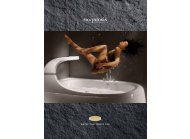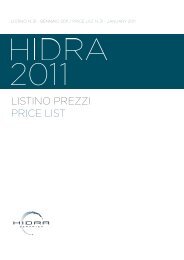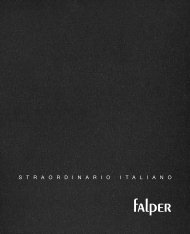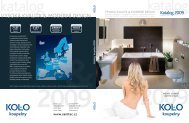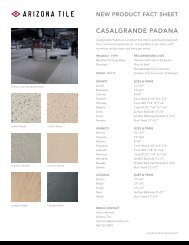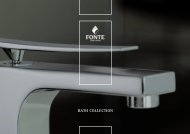DORNBRACHT - Butterfly Trading
DORNBRACHT - Butterfly Trading
DORNBRACHT - Butterfly Trading
Create successful ePaper yourself
Turn your PDF publications into a flip-book with our unique Google optimized e-Paper software.
<strong>DORNBRACHT</strong> the SPIRITof WATER Tara<br />
There are two fundamentally different types of<br />
product. Some are rather loud and obvious, and<br />
force you to notice them. The other sort of object<br />
is simply there. It takes some time to notice it,<br />
because one of its more important qualities is<br />
that you believe that you have always known it,<br />
radiating peace and implicitness. Tara is one such<br />
item. It is a fitting that in just a few years has<br />
become an icon. Tara is the product range created<br />
by Dornbracht with Sieger Design at the start of<br />
the 90s which has inspired architects, designers<br />
and developers around the world. Tara is an item<br />
that inspires with its simplicity and clarity.<br />
Water is an ambivalent material which many life<br />
forms rely on for existence. Humans, too, consist<br />
primarily of water. However, too much water occurring<br />
suddenly or without restraint can bring<br />
devastation and death. Humans have therefore<br />
always attempted to restrain it, store and direct it.<br />
The tap, a fitting for controlling the flow of water<br />
in our own homes, is the most visible expression<br />
of a range of civilising achievements. Tara is a<br />
monument raised to this ingenious human achievement,<br />
which can be used every day.<br />
The book “Tara – Armatur und Archetypus” (Tara<br />
– Fitting and Archetype) illuminates different<br />
aspects of our contact with water. Leafing<br />
through, the eye is caught by images from the New<br />
York photographer Jesse Frohman, in which Tara<br />
gradually becomes detached from its familiar<br />
environment in the bathroom and kitchen, and<br />
is connected more and more with contrasting<br />
backgrounds and materials. Screws, worked and<br />
weathered stones and wooden beams, and workshop<br />
containers: a tension exists between the perfect,<br />
high-gloss, industrial product and the results<br />
of age, destruction and patina, which look perfect<br />
in a completely different way.<br />
Yet however bewitching the images are, this is no<br />
standard book of design images with brief descriptions.<br />
In fact, this large-format book on Tara<br />
pays homage in a more discreet way, by letting<br />
distinguished authors, architects and critics speak.<br />
In his contribution on “Stainless Steel and Ecstasy<br />
of Form”, the renowned art critic Bazon Brock<br />
tells of the origins of purism as an artistic principle<br />
that, in many areas of life, represents purity<br />
and a turning away from tradition. But he also<br />
speaks of the ambivalence of purism: “Since then,”<br />
writes Brock, “one has become aware that there<br />
can be no such radical, puristic implementation of<br />
formal logical form or contrast with historical<br />
structures or artefacts.”<br />
The Swiss architecture critic Köbi Gantenbein<br />
remembers the time when a private bathroom was<br />
anything but standard, even in our part of the<br />
world. Gantenbein invented the imaginary figure<br />
140<br />
“Some objects are simply there” // “Certi oggetti semplicemente esistono” // “Algunos objetos simplemente<br />
están ahí”<br />
Max Bär, who, happily splashing, ponders on<br />
bathing and water and the future. “If we want to<br />
continue bathing, we must think about the world’s<br />
water,” says Bär, and continues “water is not a<br />
moral problem, but a global distribution problem.”<br />
The London author Jane Withers examines the<br />
changing attitudes of mind regarding bathroom<br />
design and bathing. Her analysis of the change is<br />
“From function to ritual”. With the improvement<br />
in the standard of western bathrooms, “it is in fact<br />
the West, of all places, that is looking into other<br />
cultures and into the pre-industrial past,” writes<br />
Withers, in order to rediscover a sensuousness that<br />
we have relinquished in favour of simpler ideas<br />
of hygiene. One historical discovery is the text<br />
“The Bath as a Measure of Culture”, by Sigfried<br />
Giedion, who in the 1920s worked as the secretary<br />
of the CIAM, the International Centre of Modern<br />
Architecture, and is known to have pleaded with<br />
one-sided arguments in favour of spreading the<br />
modern style. Indeed Giedion is thinking here of<br />
cultures that do not conceive the bath as “just for<br />
washing or water-sport”. In 1935, he wrote that<br />
“no culture would be able to manage without the<br />
idea of leisure”. He therefore wanted to combine<br />
bathing and leisure as in ancient Rome or in the<br />
Islamic hammam.<br />
So what does this book actually have to do with<br />
Tara? The Hamburg architecture and theatre critic<br />
Till Briegleb describes the departure from the<br />
“expensive bulk made from heavy brass, which suits<br />
oversized necklaces and bling on the tumbler”.<br />
Briegleb recapitulates the ideas and the process<br />
behind the development of Tara and how Sieger<br />
Design gave it its “aura of elegance” that has<br />
contributed to its great success to this day. “Each<br />
bathroom facility that looks half-way modern in<br />
its basic form is Tara-compatible,” states Briegleb.<br />
As Jesse Frohman and Bazon Brock previously<br />
showed: it almost lives on contrast.<br />
In another contribution, the British architect John<br />
Pawson, a self-confessed minimalist, reports from<br />
a completely different perspective. What would<br />
I do if I had to build a modern bathroom for<br />
Cistercian monks? For him, this is not a rhetorical<br />
question, but an actual building commission: He<br />
built a monastery building and the associated<br />
baths and wash-rooms for the Cistercian order in<br />
Novy Dvur in the Czech Republic. That he finally<br />
decided on using Tara is only mentioned in passing.<br />
Initially, it was more important for him to<br />
discover what his task there actually was: “The<br />
difference lay in the fact that I was not designing<br />
wet rooms as living rooms, which is how I came to<br />
see private bathrooms,” said Pawson. He selected<br />
Tara, because it belongs to those items that<br />
“should be able to be read as a whole and without<br />
distractions”.<br />
Last but not least, “Tara – Armatur und Archetypus”<br />
(Tara – Fitting and Archetype) is a book on water<br />
and our contact with this liquid material.<br />
Fondamentalmente esistono due diverse categorie<br />
di prodotti. Alcuni sono chiassosi e appariscenti,<br />
sempre in primo piano. Gli altri, semplicemente,<br />
esistono. Occorre un po’ di tempo per notarli, si<br />
pensa di conoscerli da sempre, dato il senso di<br />
calma e naturalezza che emanano, e questa è certo<br />
una delle loro più importanti qualità. Tara fa parte<br />
di questi oggetti. En Una linea di rubinetteria che<br />
in pochi anni è diventata un’icona. Con Tara, agli<br />
inizi degli anni ’90 Dornbracht e Sieger Design<br />
hanno creato una linea di prodotti che ha entusiasmato<br />
architetti, designer e imprenditori di tutto il<br />
mondo. Tara è un oggetto che stupisce per la sua<br />
semplicità ed essenzialità.<br />
L’acqua è una sostanza ambivalente. Molte forme di<br />
vita devono all’acqua la loro esistenza. Anche l’uomo<br />
è composto principalmente d’acqua. Eppure,<br />
quando fluisce troppo abbondante, improvvisa e<br />
indomita, porta morte e distruzione. Per questo<br />
l’uomo cerca da sempre di imbrigliarla, contenerla<br />
e condurne i movimenti. Il rubinetto con cui rego-<br />
“A monument that can be used every day” // “Un<br />
monumento di uso quotidiano” // “Un monumento<br />
cotidiano y útil”<br />
liamo il flusso dell’acqua nelle nostre case è dunque<br />
l’espressione più evidente tra molteplici opere<br />
di civilizzazione. Tara supera l’ingegno dell’uomo,<br />
e ne diventa monumento di uso quotidiano.<br />
L’opera “Tara – Armatur und Archetypus” (Tara –<br />
rubinetteria e archetipo) illumina diversi aspetti<br />
del nostro rapporto con l’acqua. Sfogliandone le<br />
pagine, subito colpiscono le immagini del fotografo<br />
newyorkese Jesse Frohman che a poco a poco<br />
svincola Tara dai suoi ambienti abituali, all’inizio<br />
ancora sullo sfondo, per arrivare a fonderne gli<br />
elementi con scenografie e materiali in contrasto.<br />
Viti, pietre lavorate e segnate dalle intemperie,<br />
travi di legno e recipienti da officina. Questa contrapposizione<br />
crea una tensione tra la perfezione<br />
scintillante del prodotto industriale e quella, di<br />
natura diversa, che risulta dall’invecchiamento,<br />
dalla distruzione, dalla patina.<br />
Le immagini sono talmente incantevoli da rendere<br />
l’opera totalmente diversa dalle solite raccolte di<br />
fotografia di design, che offrono solo stringate<br />
descrizioni. Il grande volume dedicato a Tara è<br />
piuttosto un omaggio discreto a cui prendono<br />
parte autori, architetti e critici eminenti. Nel suo<br />
contributo “acciaio ed estasi della forma” il celebre<br />
critico d’arte Bazon Brock racconta dell’avvento<br />
del purismo come principio d’arte, espressione di<br />
purezza e distacco dalla tradizione in molti aspetti<br />
della vita. Tuttavia Brock sottolinea anche l’ambivalenza<br />
del purismo: “Ormai è noto”, scrive Brock,<br />
“che le logiche formali della creazione non possono<br />
affermarsi in modo tanto radicale e purista senza<br />
scontrarsi con edifici storici o artefatti.”<br />
<strong>DORNBRACHT</strong> the SPIRITof WATER Tara<br />
“It almost lives on contrast” // “Tara vive esattamente<br />
di contrasti” // “Vive precisamente del contraste”<br />
Köbi Gantenbein, critico svizzero d’architettura,<br />
ricorda i tempi in cui anche dalle nostre parti il<br />
bagno privato era cosa tutt’altro che scontata.<br />
Gantenbein immagina il personaggio Max Bär che<br />
sguazzando allegramente medita sul bagno, sull’acqua<br />
e sul futuro. “Se vogliamo continuare a<br />
fare il bagno, dobbiamo preoccuparci delle nostre<br />
riserve idriche” afferma Bär. E aggiunge “l’acqua<br />
non è una questione morale, ma un problema di<br />
distribuzione su scala mondiale”.<br />
L’autrice londinese Jane Withers studia l’evoluzione<br />
dell’habitus mentale in riferimento al bagno e<br />
al design del luogo a questo preposto. “Da funzione<br />
a rituale”, questo il titolo della sua analisi.<br />
Con la diffusione delle stanze da bagno di stampo<br />
occidentale, scrive la Withers, “l’occidente<br />
guarda proprio ad altre culture e al passato preindustriale”,<br />
per ritrovare una sensualità da tempo<br />
abbandonata a vantaggio di meccaniche pratiche<br />
meramente igieniche. L’opera “Il bagno come<br />
TARA<br />
The abstract sculptures of<br />
Constantin Brancusi, containing<br />
ideas found in African<br />
and pre-historic carvings,<br />
were the inspiration for the<br />
Tara designs. Archaic materials,<br />
such as wood and<br />
stone, and an iconic representation<br />
in black and white.<br />
L’ambientazione di Tara si<br />
ispira alle sculture astratte<br />
di Constantin Brancusi, che<br />
prendono spunto dall'arte<br />
scultorea africana e preistorica.<br />
Materiali arcaici come<br />
legno e pietra e una rappresentazione<br />
iconica in bianco<br />
e nero.<br />
Las esculturas abstractas<br />
de Constantin Brancusi, con<br />
sus préstamos del arte<br />
escultórico africano y prehistórico,<br />
inspiraron la escenificación<br />
de TARA. Materiales<br />
arcaicos como la madera y<br />
la piedra y la representación<br />
icónica en blanco y negro.<br />
141





![Katalog USAKANG retro vany [ pdf, 0.6 MB ] - Butterfly Trading](https://img.yumpu.com/47275139/1/190x134/katalog-usakang-retro-vany-pdf-06-mb-butterfly-trading.jpg?quality=85)
